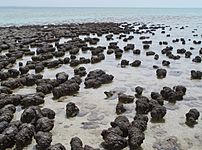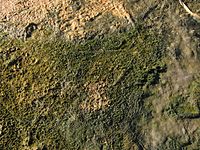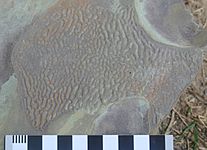Earliest known life forms facts for kids
Orange labels: known ice ages.
Also see: Human timeline and Nature timeline
The earliest known life forms found on Earth are tiny living things called microorganisms. We found their fossils in rocks in Western Australia. These rocks are super old, about 3.46 billion years! But life might have started even earlier. Scientists think life could have appeared as early as 4.28 billion years ago. That's not long after our Earth formed (4.54 billion years ago) and after the oceans appeared (4.41 billion years ago).
A life form is simply anything that is living. Scientists believe there are between 14 million and 1 trillion different kinds of life forms on Earth. Sadly, more than 99% of all species that have ever lived on Earth are now extinct. You can find life forms almost everywhere on Earth. They live deep underground, in the deepest parts of the oceans, and even high up in the atmosphere. Some can even survive in outer space!
One scientist said that tiny microbes are "extremely adaptable." This means they can live in many different conditions. They can survive almost anywhere!
Contents
Finding the First Life Forms
Scientists study fossils to learn about the origin of life. Our Earth is about 4.54 billion years old. The oldest clear signs of life we have found are from at least 3.46 billion years ago.
Ancient Discoveries
In 2017, scientists found fossils of tiny microorganisms near hydrothermal vents in Quebec, Canada. These fossils are thought to be at least 3.779 billion years old. Hydrothermal vents are like hot springs on the ocean floor.
Also in 2017, signs of life on land were found in rocks from Western Australia. These rocks are 3.48 billion years old. They are usually found near hot springs and geysers, which are like natural hot water fountains.
Life from Space?
In November 2017, a study from the University of Edinburgh suggested an interesting idea. It said that life on Earth might have started from tiny living particles. These particles could have been carried here by streams of space dust.
A biologist named Stephen Blair Hedges said something exciting. He believes that if life started quickly on Earth, then it could be common in the universe. This means there might be life on other planets too!
Gallery
-
Stromatolites may have been made by microbes.
-
Stromatolites left behind by microbes are one of the oldest fossils of life.
-
The microbe-algal mat, salty lake on the White Sea seaside.
-
Sedimentary structures formed by microbes near an ocean beach.
-
Structures formed by microbes near the Niagara Gorge, NY.
Related pages
Images for kids
-
Archaea (prokaryotic microbes) were first found in extreme environments, such as hydrothermal vents.
-
The theory of panspermia speculates that life on Earth may have come from biological matter carried by space dust or meteorites.
-
Microbialites in the Lake Salda rocks of Turkey
See also
 In Spanish: Primeras formas de vida conocidas para niños
In Spanish: Primeras formas de vida conocidas para niños









